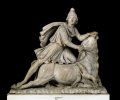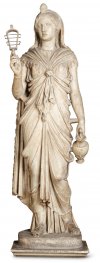The Cult of Isis and the Cult of Mithras were popular alternatives to Christianity in the Roman Empire. What if these two popular cults combined or a completely new cult formed in the worship of the God and Goddess?
You are using an out of date browser. It may not display this or other websites correctly.
You should upgrade or use an alternative browser.
You should upgrade or use an alternative browser.
WI: Mithras-Isis Syncretic Cult/Religion
- Thread starter Oba Cahokia
- Start date
I've always thought that if Mithras and one of the Great Goddess religions had merged / worked together they'd have had a decent chance. Especially if Christianity wasn't around.
I would how the would affect the Germanic Migrations into Rome and the spiritual rituals they would practice.I've always thought that if Mithras and one of the Great Goddess religions had merged / worked together they'd have had a decent chance. Especially if Christianity wasn't around.
I don't really see what Mithras brings that Isis needs, apart from misogyny and a narrower social base.
Isis tends to appeal to women. Mithras to men.I don't really see what Mithras brings that Isis needs, apart from misogyny and a narrower social base.
Cult of Mithras was known to be highly popular among the Roman army, most of what we know about it has been preserved through military records and sites.
Wonder if the rjght barracks general is able to achieve any amount of stable, long term power, could perhaps bring prestige to the Cult of Mithras? Dunno.
Wonder if the rjght barracks general is able to achieve any amount of stable, long term power, could perhaps bring prestige to the Cult of Mithras? Dunno.
Not really, Isis' priests were men and there doesn't seem to have been any evidence that men were less interested- cf the Venus Victrix cult which was folded into Isis (important to men as a martial deity and mother of the state).Isis tends to appeal to women. Mithras to men.
It's also not really true that the abrahamic god, being a man, appeals more to men than women.
Not really, Isis' priests were men and there doesn't seem to have been any evidence that men were less interested- cf the Venus Victrix cult which was folded into Isis (important to men as a martial deity and mother of the state).
It's also not really true that the abrahamic god, being a man, appeals more to men than women.
Yea. Not to mention incredibly famous “The Golden Ass/Metamorphoses” by Apuleius has him in the end becoming a devoted follower of the mysteries of Isis after she cures him of his curse in a ceremony parade that includes men and women.
“
y revelation ended, and the invincible Goddess withdrew into her own being. Instantly I was freed from sleep and leapt up, bathed in sweat, with feelings of fear and joy. Filled with utter amazement at this clear manifestation of the Great Goddess’s presence, I splashed myself with sea-water, reviewing intently her series of potent commands. Soon the dark shades of night were dispelled, a golden sun arose, and at once a crowd of triumphant believers thronged the streets. Not only was I, in my secret joy, but the whole world seemed filled with such happiness that the creatures, the skies, the very houses themselves seemed to radiate joy from their shining faces. For now a serene and sunlit morning, on the heels of yesterday’s frost, with its spring warmth enticed the birds to sing in sweet harmony, and charm with their happy greetings the Queen of the Stars; the Mother of the Seasons, the Mistress of the Universe. Even the trees, both the orchard trees that bear fruit and those simply content to give shade, gleaming with buds and roused by the southerly breeze, waved their branches gently, murmuring with a soft rustling sound, for the winter gales had ceased, the angry swell of the waves had subsided, and a calm sea now lapped the shore. The heavens too, free of the cloudy night, shone clear and naked with the splendour of their true light.
Now the vanguard of the grand procession slowly appeared, its participants in holiday attire each in finery of their choosing. One wore a soldier’s belt; another’s boots, spear and cloak proclaimed him a huntsman; another was dressed as a woman in a silk dress with gilded sandals and curly wig, and walked in a mincing manner; yet another looked like a gladiator in helmet and greaves with shield and sword. There was a magistrate it seemed with the purple toga and rods of office; and there a philosopher with a goatee beard, in a cloak with a staff and woven sandals. Here were a brace of long poles, one a fowler’s with his bird-lime, the other a fisherman’s with line and hooks. Behold a tame bear dressed as a housewife, borne in a sedan chair; and look, an ape in a Phrygian straw hat and saffron robe, dressed as the shepherd lad Ganymede and waving a golden cup. And lastly an ass, wings glued to its shoulders, with a decrepit old man on its back, a Bellerophon and his Pegasus, enough to split your sides.
But behind these laughter-loving crowd-pleasers wandering all over the place, the procession proper was readying itself to celebrate the Goddess who saves. At its head went women in gleaming white, garlanded with the flowers of spring, rejoicing in their varied burdens, scattering blossoms along the path where the sacred gathering would pass; others had shining mirrors fastened to their backs to show their obedience to the goddess who would follow; or they bore ivory combs and feigned to shape and dress the Goddess’s royal hair; while others sprinkled the streets with pleasant balsam and fragrances. There followed a throng of men and women, carrying every means of shedding light, such as torches, lamps and wax-candles to honour the source of the celestial stars.
Now, musicians with pipes and flutes appeared, playing pure melodies, pursued by a fine choir of chosen youths, gleaming in their snow white holiday robes and singing a delightful hymn, composed by a talented poet aided by the Muses, whose words acted as prelude to the Greater Vows to come. Here were the temple pipers of the great god Serapis too, playing their traditional anthem on slanting flutes extending close to the right ear. And then the heralds passed, warning the people openly to clear a path for the holy procession.
A mighty throng of men and women of every age and rank, initiates of the sacred mysteries, poured on behind, their linen robes shining radiantly, the women’s hair in glossy coils under transparent veils, the men’s heads closely shaved and glistening, the earthly stars of the great rite. And each one shook a sistrum of bronze or silver or sometimes gold, giving out a shrill tinkling sound. The foremost priests of the cult came next, in white linen, drawn tight across their chests and hanging to their feet, carrying the distinctive emblems of the powerful gods.
The first held a glittering lamp, not like the lamps we use to light our nocturnal feasts but shaped like a golden boat with a tall flame flaring from its central vent. The second priest carried an altar-top, that is, a source of help, its name auxilia derived from the auxiliary aid the Great Goddess brings. Then the third approached, holding on high a branch of palm its leaves of fine gold, and a caduceus, like Mercury. A fourth showed a cast of a left hand with fingers extended, a symbol of justice, since the left hand’s natural clumsiness, lack of quickness and dexterity, is more appropriate to justice than the right; and he carried a little golden vessel shaped like a woman’s breast, from which he poured milk as a libation. The fifth held a winnowing fan woven from twigs of gold not willow, and a sixth priest bore an amphora.
Behind them came the gods deigning to walk on human feet, firstly Anubis that dread messenger between the powers above and the powers beneath the earth, with a face one side black the other gold, his jackal’s neck erect, bearing a caduceus in his left hand, and a green palm-branch in his right. In his footsteps a priest with proud and measured step carried a statue on his shoulders, a cow seated upright; the cow being a fruitful symbol of the divine Mother of all. Another bore a basket containing secret implements, concealed objects of great sanctity, while a third fortunate priest carried an ancient image of the Great Goddess in the lap of his robe, not in the shape of any beast wild or tame, or bird or human being, but inspiring reverence in its skilled working by its very strangeness, being the ineffable symbol somehow of a deeper sacredness, to be cloaked in awful silence, formed as it was of gleaming gold after this manner: it took the form of a little hollow urn, its surface engraved with Egyptian hieroglyphics, with a rounded base, an extended spout opened slightly like a beak, and a broad curving handle at the opposite side extending backwards deeply from which an asp, coiled in a knot, reared its scaly swollen neck on high.
Last edited:
Share:

